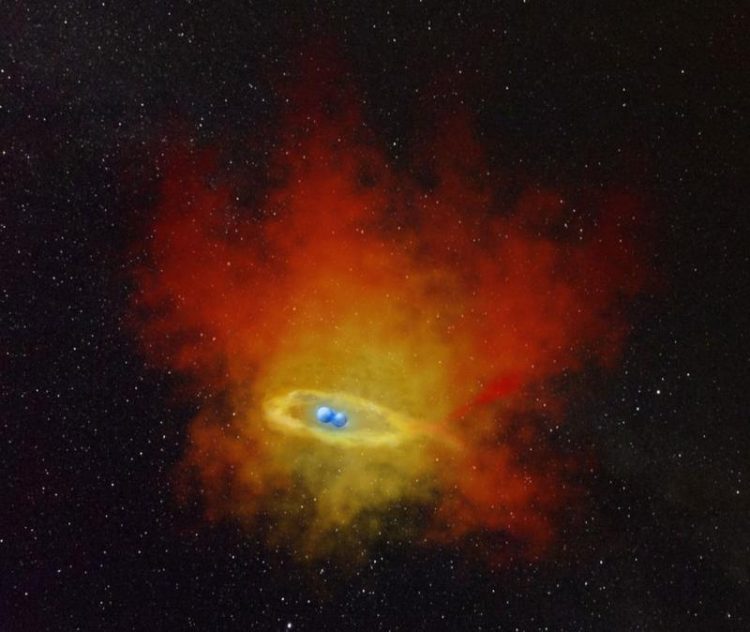All-clear in space – Cuddling inside a nebula does not have to end in a catastrophe

An artist’s impression of the two merging central stars inside the planetary nebula Henize 2-428 Nicole Reindl
Supernova explosions are catastrophic explosions of stars in space, were different types are distinguished. A supernova type Ia or thermonuclear supernova occurs when a white dwarf star acquires extra mass — either by accretion from a stellar companion or by merging with another white dwarf.
Because the explosion always releases the same amount of energy, type Ia supernovae are often used to measure astronomical distances. However, the nature of the progenitor systems that leads to this kind of explosion is still elusive.
Consequently, large observational and theoretical effort is put into finding such systems.
The only definite candidate for a progenitor system of a supernova type Ia scenario was the nucleus of the planetary nebula Henize 2-428 in the constellation Aquila, consisting of a close pair of white dwarf stars that orbit each other in close distance every four hours.
The two stars are actually so close that they even share a common envelope. Back in 2015, an article published in the renowned journal Nature claimed a total mass of the two stars of about 1.8 times that of the Sun, which is high enough for triggering a supernova type Ia explosion.
A careful re-analysis of this system performed by an international team of astronomers led by Dr. Nicole Reindl now comes to a completely different conclusion. In their article, which appears as Highlight in the journal Astronomy & Astrophysics, they show that the total mass of the system has been significantly overestimated and that the merger of the two stars will not produce a supernova explosion.
“One has to be very careful when analyzing the observations of central stars of planetary nebula” stresses Reindl, “not only the material from the surrounding nebula can lead to a contamination of the measurements, but also the gas that is between us and the stars”.
Planetary nebulae are the expanding, glowing shells of ionized gas ejected from stars late in their lives. By modeling these nebula contributions and interstellar gases, the team could show that the total mass of the system only slightly exceeds one solar mass. This is far too low to produce a supernova Ia explosion and, therefore, the race to find a definite supernova type Ia progenitor system is re-opened.
The authors suggest that the merger of the two stars will instead give rise to a new star with an exotic atmospheric composition. “Every so often such exotic stars are found amongst white dwarf stars, and they are not very well understood”, explains Reindl. The team hopes now that their work will push forward investigation on these stars as well.
Publication:
N. Reindl, V. Schaffenroth, M. M. Miller Bertolami, S. Geier, N. L. Finch, M. A. Barstow Finch, S. L. Casewell and S. Taubenberger (2020) An in-depth reanalysis of the alleged type Ia supernova progenitor Henize 2-428, Astronomy & Astrophysics.
www.aanda.org/10.1051/0004-6361/202038117
Image:
An artist’s impression of the two merging central stars inside the planetary nebula Henize 2-428. Image Credit: Nicole Reindl
Kontakt:
Dr. Nicole Reindl, Institute of Physics and Astronomy
E-Mail: nreindl@gmail.com
Phone: +49 176 775 10 763
Medieninformation 24-06-2020 / Nr. XXX
Dr. Stefanie Mikulla
Universität Potsdam
Referat Presse- und Öffentlichkeitsarbeit
Am Neuen Palais 10
14469 Potsdam
Tel.: +49 331 977-1474
Fax: +49 331 977-1130
E-Mail: presse@uni-potsdam.de
Internet: www.uni-potsdam.de/presse
Dr. Nicole Reindl, Institute of Physics and Astronomy
E-Mail: nreindl@gmail.com
Phone: +49 176 775 10 763
N. Reindl, V. Schaffenroth, M. M. Miller Bertolami, S. Geier, N. L. Finch, M. A. Barstow Finch, S. L. Casewell and S. Taubenberger (2020) An in-depth reanalysis of the alleged type Ia supernova progenitor Henize 2-428, Astronomy & Astrophysics.
Media Contact
All latest news from the category: Physics and Astronomy
This area deals with the fundamental laws and building blocks of nature and how they interact, the properties and the behavior of matter, and research into space and time and their structures.
innovations-report provides in-depth reports and articles on subjects such as astrophysics, laser technologies, nuclear, quantum, particle and solid-state physics, nanotechnologies, planetary research and findings (Mars, Venus) and developments related to the Hubble Telescope.
Newest articles

Properties of new materials for microchips
… can now be measured well. Reseachers of Delft University of Technology demonstrated measuring performance properties of ultrathin silicon membranes. Making ever smaller and more powerful chips requires new ultrathin…

Floating solar’s potential
… to support sustainable development by addressing climate, water, and energy goals holistically. A new study published this week in Nature Energy raises the potential for floating solar photovoltaics (FPV)…

Skyrmions move at record speeds
… a step towards the computing of the future. An international research team led by scientists from the CNRS1 has discovered that the magnetic nanobubbles2 known as skyrmions can be…





















